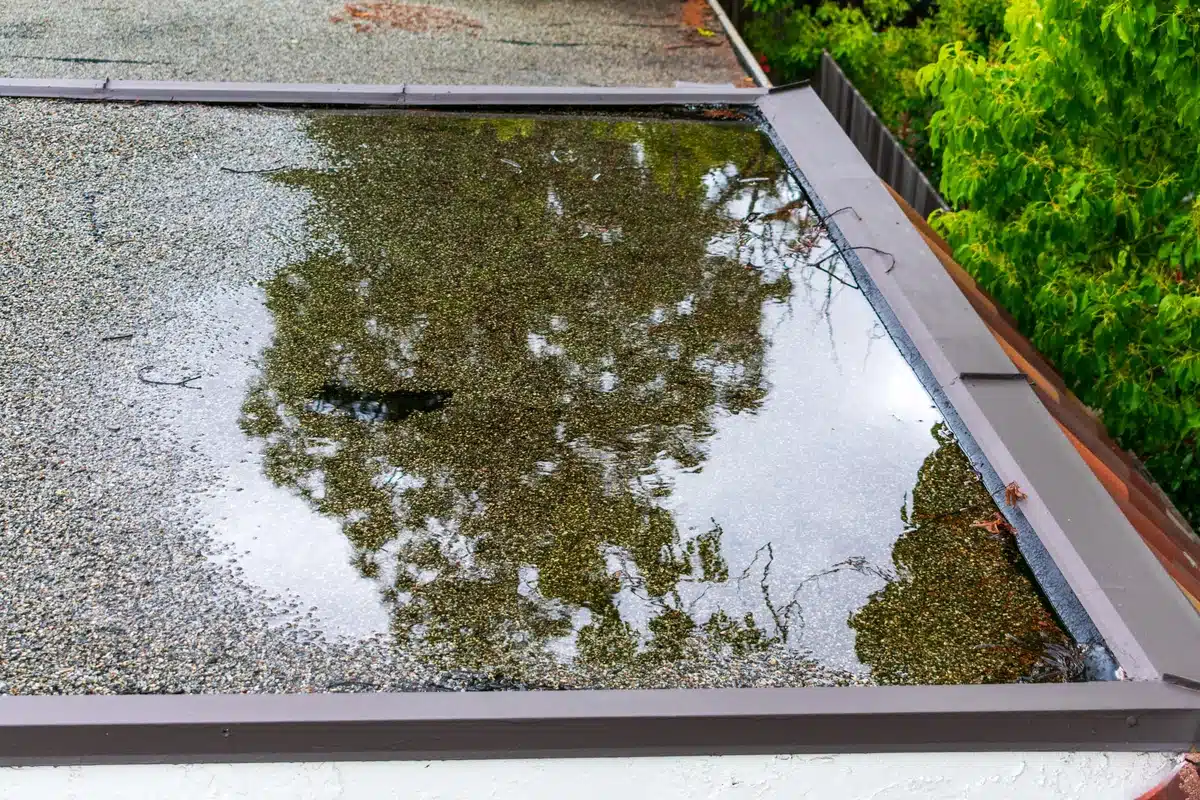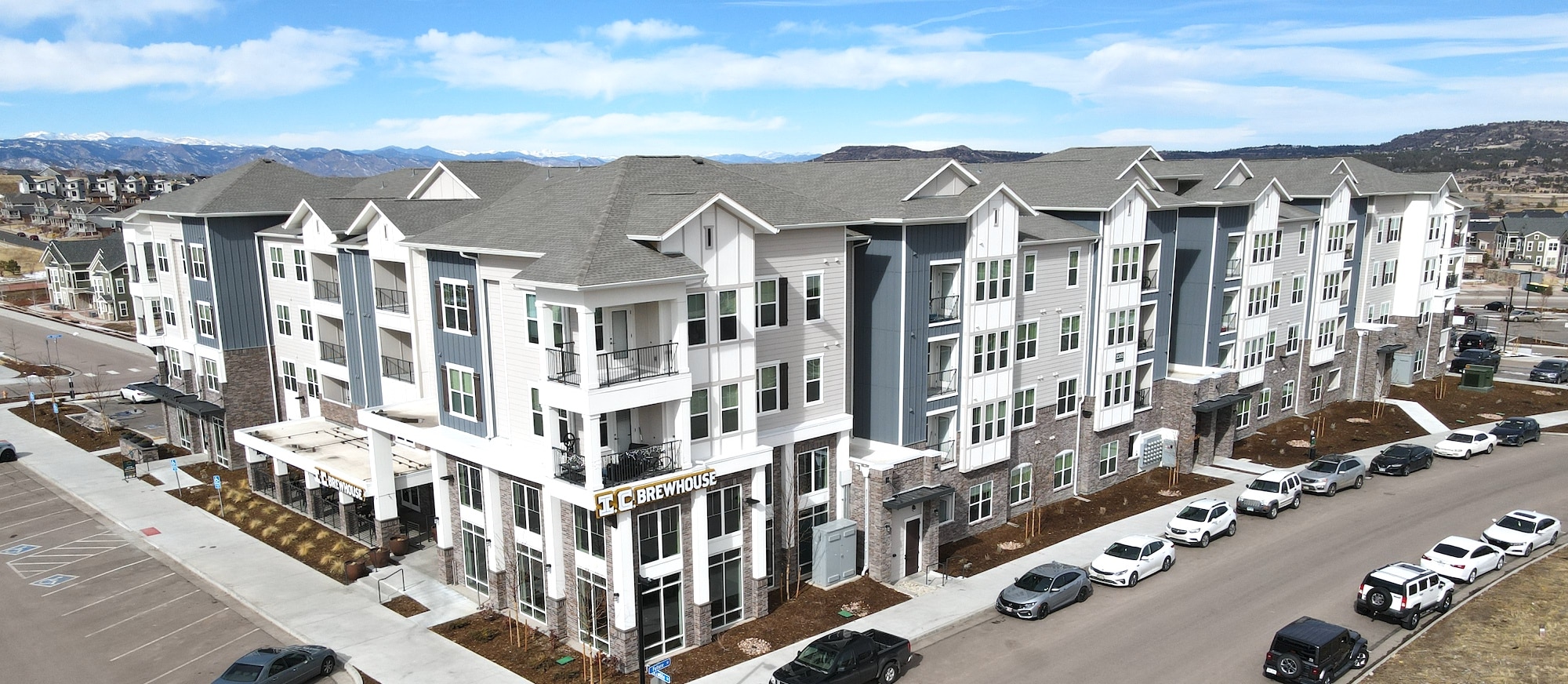Table of Contents
Ponding Water On Flat Roof
Due to their design, flat roofs are known to collect water when it rains. However, if you start to notice that there’s excessive ponding water on your roof that doesn’t evaporate within 8 hours or less, then you have a problem on your hands.
Fortunately, ponding water on commercial roofs isn’t all that difficult to figure out on your own. In this article, we’ll walk you through the entire process of fixing your ponding water problem before it’s too late.

Why It’s Important to Address Ponding Water
The most obvious issue posed by ponding water is the fact that it can and will lead to water leakage. There are several factors that will contribute to leakage on a flat roof system with ponding water, including:
Improper Drainage 💧
Water will always move towards the lowest point that it can reach on a roof, which is why having a proper drainage system on your flat roof is essential. This would include a drain or gutter — or both.
However, if water starts pooling on your roof without draining into one or both of these systems, it’s going to start looking for the lowest place it can reach, thanks to its weight and gravity. This means it’ll eventually start seeping into the cracks that will lead it through your flat roof membrane and roof deck until it comes through your ceiling.
If you’re wondering where these cracks come from, they tend to form wherever the water sits for a long period of time. This is because the moisture and weight that come with pooling water weaken the structure of flat roofs, which leads to cracks and holes. [Ponding Water On Flat Roof]
Ultraviolet Rays ☀️
The issues with ponding water on a flat roof system don’t end there. Puddles of water on a roof will also act as a magnifying glass for ultraviolet (UV) rays.
While commercial flat roofs are designed to withstand the regular effects of UV rays, they’re not designed to deal with the effects under magnified circumstances. This can lead to deterioration of the roof’s surface. [Ponding Water On Flat Roof]
Dirt and Debris 🧹
Lastly, ponding water on flat roof systems tends to collect dirt and debris from the entire surface of the roof. The dirt and debris will eventually be left behind once the water finally evaporates, and it’ll begin to grow vegetation that will, in fact, damage your roofing materials.
How to Address Ponding Water on Flat Roof Systems

The last thing you want is to have to deal with costly repairs or even more costly structural damages due to ponding water leaks. If you start to notice that water is pooling on your flat roof for longer periods of time, these are the steps you’ll want to take to address it before it’s too late:
- Check the drainage. Your drainage system is the first place you want to inspect when you have ponding water on your roof and as part of regular commercial roof maintenance. It’s also the easiest thing to fix. So, start by checking to see if your drain or gutters are clogged from debris. If they’re clogged, you can unclog them and see how it goes — however, you may need to install an extra drainage channel. In this case, you’ll need to call your local roofing professional.
- Check for low spots. If drainage isn’t your issue, you’ll need to check for low spots. Keep in mind that water will always flow towards the lowest spots, so if your roof has indented or depressed areas, that’s where it’ll collect. These areas will need to be filled in (usually by a professional) to the point where they provide an additional slope to guide water into your drainage systems
- Check your roof slope. If your flat roof is clear of the above two issues, its slope may be the problem. Even flat roofs have a certain pitch that pushes water toward their drainage system, but yours may have been installed improperly. If this is the case, it’ll require an additional slope or complete roof replacement.
How to Fix Ponding Water on Flat Roofs
While unclogging your drainage system is self-explanatory, there are certain things you need to know if you plan to tackle the other two ponding water issues on your own. [Ponding Water On Flat Roof]
Filling Low Spots
If you’d prefer to take a DIY approach to those low spots, the basic method involves building up layers of rolled asphalt roofing.
Here’s what you need to do:
- First, make sure the low area is completely dry (you can use rags or towels to blot the area if it’s still damp)
- Cut out a 12-inch circle of asphalt roofing and apply a thin layer of roofing cement to the bottom. Be sure to spread it evenly around the edges as well.
- Place the asphalt roofing right at the center of the low spot and firmly press it into place.
- Now, cut a 16-inch circle from your asphalt roofing material and apply it the same way.
- From there, cut more circles — adding four inches with each new layer — and apply them the same way. You’ll likely need at least 10 layers.
- Now cut two pieces of nylon roofing material that’s four inches larger than your last circle and them with the roofing cement on top of each other.
- Finish it off by painting your patchwork and its surrounding area with a thick layer of rubberized elastomeric coating. [Ponding Water On Flat Roof]
Fixing the Slope
Fixing the slope of a commercial roof is much more involved. Theoretically speaking, a slope of 1% (or ⅛ inch per foot) is right for draining water. However, your local building codes may require twice that amount, so you’ll need to check that first, as it may mean you’ll need a complete roof replacement. [Ponding Water On Flat Roof]
Fixing your roof’s slope will likely require using tapered insulation. Tapered insulation is installed by using slope panels made of solid insulation, usually four feet by four feet in size. It also requires a little bit of technical know-how, which is why it’s strongly recommended that you leave the project up to the roofing professionals. [Ponding Water On Flat Roof]
Let Us Fix Your Flat Roof Issues

Ponding water on commercial roof systems is a serious issue, and if you don’t address it in time, you’re looking at even more serious issues down the line. You also don’t want to waste time and money filling in low spots when what you really need is a flat roof replacement. [Ponding Water On Flat Roof]
The roofing professionals at Tectum Roofing can offer you a comprehensive flat roof inspection to determine whether your ponding water issue requires a simple repair or total roof replacement. Get in touch with us today to schedule your free inspection!. [Ponding Water On Flat Roof]



